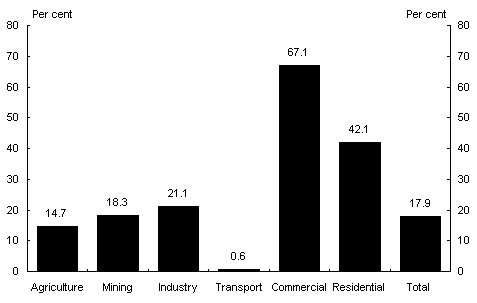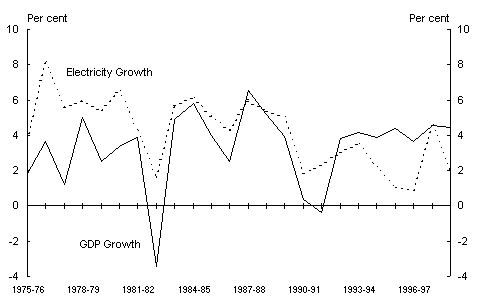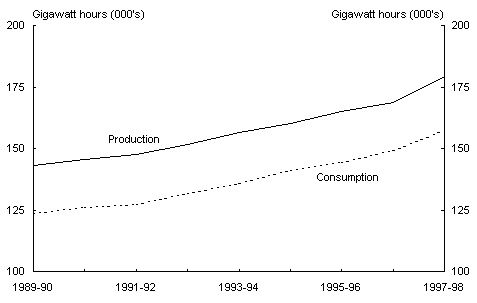This article examines developments in Australias electricity supply industry over the past decade. The article outlines the impetus for reforms, their impact on the industry and emerging trends.
Introduction
The electricity supply industry is a key sector of the economy, both in terms of the essential service it provides to consumers and its contribution to broader economic performance. With its abundance of coal and natural gas reserves, Australia has a comparative advantage in energy supply that has contributed to growth opportunities for the economy as a whole. The electricity sector also accounts for large amounts of capital expenditure and provides an essential input to almost all businesses in the economy.
The electricity industry has undergone major changes over the last decade beginning with major structural changes in some States in the early 1990s, and continuing with the introduction of National Competition Policy reforms in 1995. Benefits from these reforms are already apparent although the reform process is in a transitional phase and its full effects are yet to eventuate.
Path to reform
In 1991, the Industry Commission released a report on Australias natural gas and electricity sectors. The report, Energy Generation and Distribution, noted that:
The electricity and gas sectors have not been performing to their full potential Poor investment decisions leading to excess capacity and gross over staffing during the 1980s provide the most striking evidence that electricity and gas have not been supplied at least cost.
The report identified a number of inefficiencies in the electricity industry, including the following.
-
Capital utilisation, as measured by reserve plant margins, ranged between 40 and 70 per cent over the mid to late 1980s across Australia, compared with an international benchmark of between 20 and 25 per cent. These high reserve plant margins indicated substantial excess capacity in the electricity industry.
-
There were substantial disparities between the cost of electricity supply and prices charged, with commercial and industrial consumers paying significantly more than the cost of supply.
Prior to 1990, the electricity supply industry in each State or Territory was generally characterised by a vertically integrated government-owned body responsible for the generation, transmission, distribution and retailing of electricity. The Industry Commission report recommended corporatisation and structural separation of electricity utilities as well as a network access regime.
|
Box 1: Corporatisation, structural separation and access
While corporatisation provides the managers of electricity infrastructure with improved incentives for performance, structural separation and access are the keys to creating a competitive environment. Separating ownership and control of different parts of electricity infrastructure ensures that an entity cannot use its control over natural monopoly infrastructure in order to gain an unfair advantage over rivals in contestable markets. Access regulation ensures that contestable parts of the industry can gain access on reasonable terms and conditions to bottleneck facilities. |
Most States and Territories have structurally separated their electricity industries only Western Australia and the Northern Territory still have vertically integrated electricity businesses. Victoria has gone a step further and privatised its electricity assets, while South Australia is in the process of privatising its electricity assets by means of a long-term lease.
Reforms in the electricity industry gained particular momentum from recommendations of the Hilmer Committee on National Competition Policy in 1993. As part of their commitment in 1995 to implement National Competition Policy and the related reforms, State and Territory Governments agreed that progress in reforming the energy sector would be a condition for National Competition Payments from the Commonwealth Government.
The Productivity Commission has estimated that implementation of electricity and gas reforms will increase real gross domestic product by 1.1 per cent. This means that, in the long-run, the Australian economy will be approximately $6.2 billion per year larger than would be the case in the absence of the reforms.
The national electricity market
A key focus of electricity reform has been the establishment of the National Electricity Market (NEM). The NEM is a single wholesale market for electricity in the Australian Capital Territory (ACT), New South Wales (NSW), Queensland, South Australia and Victoria. The first stage of interstate trade commenced in May 1997, with trading between the ACT, NSW and Victoria. Full operation of the NEM, incorporating the other jurisdictions, commenced in December 1998.
Queensland is currently an isolated participant in the NEM but two interconnections to the NSW grid are currently under construction. Both interconnectors are expected to be operational in the year 2000-01. Tasmania may also join the NEM if an interconnection with Victoria across the Bass Strait is established. Western Australia and the Northern Territory are considered unlikely to join due to the long transmission distances involved. However, these jurisdictions are also in the process of implementing electricity reforms.
The National Electricity Code, in conjunction with Part IIIA of the Trade Practices Act 1974, sets out a framework for access to electricity transmission and distribution networks. This has facilitated the introduction of competition at the generation and retail levels of the electricity industry.
The NEM will eventually evolve to a stage where all customers within the NEM will have the opportunity to choose their electricity retailer, ie their electricity supply will be contestable. At present, supply to over 29,000 customers in the NEM who consume more than 160 megawatt hours (MWh) per year (eg large commercial customers, supermarkets and fast food restaurants) is contestable. Based on expected timetables, over 6.5 million small business and residential customers in Victoria, NSW, Queensland and the ACT will be able to choose their electricit
y retailer by January 2001, with supply to an additional 700,000 customers in South Australia set to become contestable by January 2003.
Developments in the Electricity Industry
Electricity is a vital input to a wide range of Australian industries and provides an essential service to households. Electricity accounts for almost 18 per cent of Australias total energy needs (Chart 1).
Chart 1: Electricity consumption as a percentage of total energy consumed, 1995-96

Source: Australian Gas Association, Gas Statistics Australia 1998.
The electricity supply industry generated $13 billion in sales to final consumers in 1997-98 and accounts for around 1.6 per cent of GDP. In addition, electricity accounts for around 2 per cent of industry non-labour current costs. For some energy intensive industries, such as aluminium smelting and non-ferrous metals, electricity is a much higher proportion of overall costs.
Growth
Electricity generation has undergone strong growth in recent years due, in particular, to rapid growth in sectors where electricity is the prime fuel source, such as the commercial and non-ferrous metals sectors. Since 1975-76, growth in the electricity industry, in terms of value added production, has averaged around 4.3 per cent compared with an economy-wide average of around 3.3 per cent (Chart 2).
Chart 2: Electricity growth and GDP growth

Source: ABS Cat. No. 5206-48.
The sharp decline in the rate of electricity growth from 1993-94 to 1996-97 was largely attributable to a slow-down in manufacturing activity, predominantly in Victoria. The subsequent rise in the rate of growth largely stemmed from new mining and manufacturing activity, particularly in Queensland.
Production and consumption of electricity have also experienced strong growth over the past decade, rising by 17 and 20 per cent respectively from 1989-90 to 1997-98 (Chart 3). The difference between consumption and production is due to transmission losses and ancillary services.
Chart 3: Electricity production and consumption

Source: ESAA, Electricity Australia (various issues).
1 Industry Commission (1991), Energy Generation and Distribution Volume I, Commonwealth Government Printer, Canberra, p. 1.
2 Industry Commission (1991), Energy Generation and Distribution Volume II, Commonwealth Government Printer, Canberra.
3 The reserve plant margin is the total plant capacity available less the actual maximum demand for electricity in a particular year, expressed as a percentage of maximum demand.
4 Productivity Commission (1999), Impact of Competition Policy Reforms on Rural and Regional Australia, Report no. 8, Ausinfo, Canberra. 1997-98 figures.
5 As an isolated participant, Queensland does not trade electricity with the other States but has operated a wholesale market for electricity under NEM rules since January 1998.
6 Electricity Supply Association of Australia (ESAA) (1999), Electricity Australia 1999, Gotham Press, Sydney.
7 ABS Cat. No. 5206-48.
8 ABS Cat. No. 5215.0.